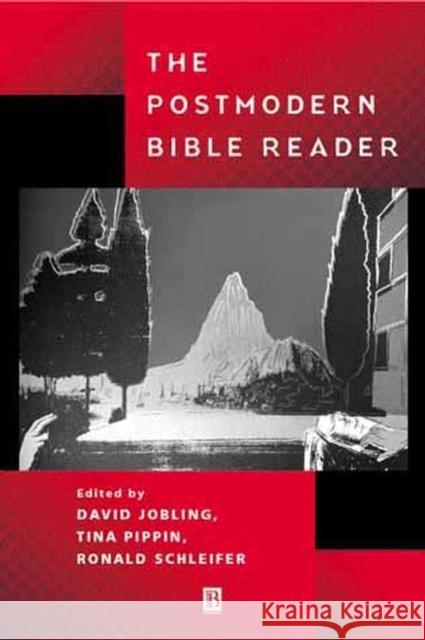Postmodern Bible Reader » książka



Postmodern Bible Reader
ISBN-13: 9780631219620 / Angielski / Miękka / 2001 / 400 str.
Postmodern Bible Reader
ISBN-13: 9780631219620 / Angielski / Miękka / 2001 / 400 str.
(netto: 228,65 VAT: 5%)
Najniższa cena z 30 dni: 238,60
ok. 30 dni roboczych
Dostawa w 2026 r.
Darmowa dostawa!
A range of powerful contemporary engagements with the Bible by literary critics, philosophers, writers and activists is brought together for the first time in this Reader.
′Some six years after the publication of
The Postmodern Bible, this reader offers a complex and challenging companion volume to the earlier work. Drawn from the work of critics, both well–known and less familiar, it offers a contextualisation of the Bible in the contemporary in essays which read against, through and with biblical texts themselves. A superb Introduction challenges the reader through the work of seven key writers from Lyotard to Zizek, expanding the terms of the debate culturally and intellectually, reminding us that ′the postmodern′ is not static, but dynamic and shifting. It will provide an invaluable resource for teachers and students. Its tone is often polemical, rhetorical and always stimulating. It brings postmodernism alive again, and therefore also the Bible. For we cannot now read the Bible outside the claims of postmodernity. The book deserves a wide readership, especially, one hopes, among biblical scholars and their students.′
David Jasper, University of Glasgow
"...this volume is certain to become an indispensable resource for biblical scholars, theologians, seminarians, and graduate students." Teaching Theology & Religion
Preface.
Acknowledgments.
Introduction: A Short Course in Postmodernism for Bible Readers.
Epigraph: "Green Grass, Running Water" by Thomas King.
Part I: Rereading the Bible:.
Introduction.
1. The Structural Analysis of Narrative: Apropos of Acts 10–11: Roland Barthes.
2. On the Possibility of Generating Aesthetic Messages in an Edenic Language: Umberto Eco.
3. Reading the Bible: Julia Kristeva.
4. Introduction to the Names–of–the–Father Seminar: Jacques Lacan.
5. Dreaming in 1990: HÚlÞne Cixous.
6. Parable and Performative in the Gospels and in Modern Literature: J. Hillis Miller.
7. Body Politic: Mieke Bal.
Part II: The Politics of Reading:.
Introduction.
8. J. L. Austin and the Book of Jonah: Terry Eagleton.
9. The Song of Mark (Luke 1:46–55): Ernesto Cardenal.
10. A Native American Perspective: Canaanites, Cowboys, and Indians: Robert Allen Warrior.
11. Slave Ideology and Biblical Interpretation: Katie Geneva Cannon.
12. Ecce Homo, Ain′t (Ar′n′t) I a Woman, and Inappropriate/d Others: The Human in a Post–Humanist Landscape: Donna Haraway.
13. A Pedagogy for Post–Colonial Feminists: Zakia Pathak.
14. From The Book of Sodom: Paul Hallam.
Part III: The conscience of the Bible:.
Introduction.
15. Meals Among Brothers: Theory of the Joker: Michel Serres.
16. The Interior Structure of Made Objects: Elaine Scarry.
17. From Ethics and Community: Enrique Dussel.
18. On the Jewish Reading of Scriptures: Emmanuel Levinas.
19. Whom to Give to (Knowing Not to Know): Jacques Derrida.
20. "Draupadi" by Mahasweta Devi: Gayatri Chakravorty Spivak.
Index.
David Jobling teaches at St Andrew′s College, Canada, and is General Editor of Semeia. He is author of
The Sense of Biblical Narrative and I Samuel.
Tina Pippin is Associate Professor of Religion at Agnes Scott College in Decatur, Georgia. She is the author of Apocalyptic Bodies: The Biblical End of the World in Text and Image (1999).
David Jobling teaches at St Andrew′s College, Saskatoon, Canada, and is General Editor of Semeia. He is author of The Sense of Biblical Narrative and I Samuel.
Tina Pippin is Associate Professor of Religion at Agnes Scott College in Decatur, Georgia. She is the author of Apocalyptic Bodies: The Biblical End of the World in Text and Image.
Ronald Schleifer teaches at the University of Oklahoma and is co–editor of ′The Oklahoma Project for Discourse and Theory′. He is author of A. J. Greimas and the Nature of Meaning.
A range of powerful contemporary engagements with the Bible by literary critics, philosophers, writers, and activists is brought together for the first time in this Reader. The twenty texts anthologized allow students to explore and interrogate different ways of making the Bible part of the postmodern world. The selection is based on the editors′ experience of which texts best engage students and stimulate discussion in the classroom.
A broad range of theoretical and cultural voices is represented, including creative approaches and queer theory. Each work is introduced by editorial comment tracing its definitions and history, and part introductions outline the interrelations between documents. In addition, a general introduction by the editors offers ′A Short Course on Postmodernism for Bible Readers′, proposing seven seminal theoretical texts which students can read to gain an overview of postmodern thought.
The Postmodern Bible Reader is an ideal complement to the successful A Postmodern Bible (1995) and like this text, communicates the excitement and controversy generated by new approaches to biblical studies.
1997-2025 DolnySlask.com Agencja Internetowa
KrainaKsiazek.PL - Księgarnia Internetowa









